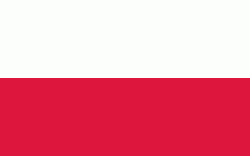Łódź
Łódź, also seen without diacritics as Lodz, is a city in central Poland and a former industrial centre. It is the capital of Łódź Voivodeship, and is located approximately 120 km south-west of Warsaw. The city's coat of arms is an example of canting, as it depicts a boat (łódź in Polish), which alludes to the city's name. Łódź has a population of 670,642 making it the country's fourth largest city.
Łódź was once a small settlement that first appeared in 14th-century records. It was granted town rights in 1423 by Polish King Władysław II Jagiełło and it remained a private town of the Kuyavian bishops and clergy until the late 18th century. In the Second Partition of Poland in 1793, Łódź was annexed to Prussia before becoming part of the Napoleonic Duchy of Warsaw; the city joined Congress Poland, a Russian client state, at the 1815 Congress of Vienna. The Second Industrial Revolution (from 1870) brought rapid growth in textile manufacturing and in population owing to the inflow of migrants, notably Germans and Jews. Ever since the industrialization of the area, the city has been multinational and struggled with social inequalities, as documented in the novel The Promised Land by Nobel Prize–winning author Władysław Reymont. The contrasts greatly reflected on the architecture of the city, where luxurious mansions coexisted with red-brick factories and dilapidated tenement houses.
The industrial development and demographic surge made Łódź one of the largest cities in Poland. Under the German occupation during World War II Łódź was briefly renamed Litzmannstadt after Karl Litzmann. The city's population was persecuted and its large Jewish minority was forced into a walled zone known as the Łódź Ghetto, from where they were sent to German concentration and extermination camps. The city became Poland's temporary seat of power in 1945.
Łódź experienced a sharp demographic and economic decline after 1989. It was only in the 2010s that the city began to experience revitalization of its neglected downtown area. Łódź is ranked by the Globalization and World Cities Research Network on the “Sufficiency” level of global influence and is internationally known for its National Film School, a cradle for the most renowned Polish actors and directors, including Andrzej Wajda and Roman Polanski. In 2017, the city was inducted into the UNESCO Creative Cities Network and named UNESCO City of Film.
The Polish name for the city, Łódź, directly translates to 'boat' in the English language. There is no unanimous consensus on its precise origin, but popular theories link it with the medieval village of Lodzia and the now-canalised River Łódka on which the modern city was founded. It may have also derived from the term łoza denoting a willow tree and the personal Old Polish name Włodzisław.
Łódź was once a small settlement that first appeared in 14th-century records. It was granted town rights in 1423 by Polish King Władysław II Jagiełło and it remained a private town of the Kuyavian bishops and clergy until the late 18th century. In the Second Partition of Poland in 1793, Łódź was annexed to Prussia before becoming part of the Napoleonic Duchy of Warsaw; the city joined Congress Poland, a Russian client state, at the 1815 Congress of Vienna. The Second Industrial Revolution (from 1870) brought rapid growth in textile manufacturing and in population owing to the inflow of migrants, notably Germans and Jews. Ever since the industrialization of the area, the city has been multinational and struggled with social inequalities, as documented in the novel The Promised Land by Nobel Prize–winning author Władysław Reymont. The contrasts greatly reflected on the architecture of the city, where luxurious mansions coexisted with red-brick factories and dilapidated tenement houses.
The industrial development and demographic surge made Łódź one of the largest cities in Poland. Under the German occupation during World War II Łódź was briefly renamed Litzmannstadt after Karl Litzmann. The city's population was persecuted and its large Jewish minority was forced into a walled zone known as the Łódź Ghetto, from where they were sent to German concentration and extermination camps. The city became Poland's temporary seat of power in 1945.
Łódź experienced a sharp demographic and economic decline after 1989. It was only in the 2010s that the city began to experience revitalization of its neglected downtown area. Łódź is ranked by the Globalization and World Cities Research Network on the “Sufficiency” level of global influence and is internationally known for its National Film School, a cradle for the most renowned Polish actors and directors, including Andrzej Wajda and Roman Polanski. In 2017, the city was inducted into the UNESCO Creative Cities Network and named UNESCO City of Film.
The Polish name for the city, Łódź, directly translates to 'boat' in the English language. There is no unanimous consensus on its precise origin, but popular theories link it with the medieval village of Lodzia and the now-canalised River Łódka on which the modern city was founded. It may have also derived from the term łoza denoting a willow tree and the personal Old Polish name Włodzisław.
Map - Łódź
Map
Country - Poland
 |
 |
| Flag of Poland | |
Poland has a temperate transitional climate and its territory traverses the Central European Plain, extending from Baltic Sea in the north to Sudeten and Carpathian Mountains in the south. The longest Polish river is the Vistula, and Poland's highest point is Mount Rysy, situated in the Tatra mountain range of the Carpathians. The country is bordered by Lithuania and Russia to the northeast, Belarus and Ukraine to the east, Slovakia and the Czech Republic to the south, and Germany to the west. It also shares maritime boundaries with Denmark and Sweden.
Currency / Language
| ISO | Currency | Symbol | Significant figures |
|---|---|---|---|
| PLN | Polish złoty | zÅ‚ | 2 |
| ISO | Language |
|---|---|
| PL | Polish language |
















